The X Button
Vita Stats
by Todd Ciolek,

You know, I'm really starting to like Nintendo of Europe. That's partly because they decided to release Xenoblade Chronicles, The Last Story, and Pandora's Tower for the European Wii while Nintendo of America only announced Xenoblade. But it's also because Nintendo of Europe took advantage of this holiday to announce a release date for Pandora's Tower, the last of the three games to hit Europe. And the company didn't just send out of press release. No, they made some Valentine's Day cards for Pandora's Tower.
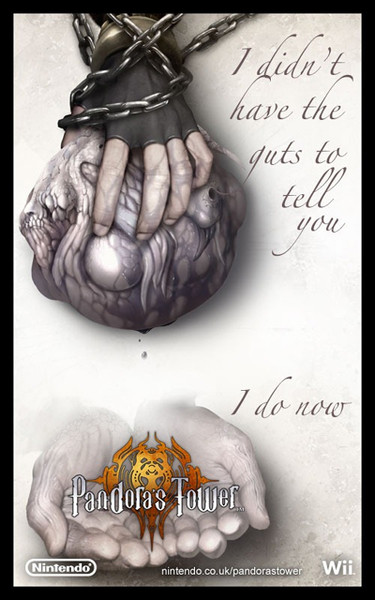
These romantic overtures, available through the official site, play off of the game's visceral premise. A woman named Ceres is cursed to slowly and painfully transform into a demon. Her only hope for a cure lies in devouring the innards of monsters, so a warrior named Ende sets off to slaughter as many of them as he can. When Ende isn't out eviscerating creatures with his useful chain weapon, he builds a relationship with Ceres, because someone who's gulping down demon hearts needs plenty of emotional support. Nintendo of Europe changed a few names for the English version: Ceres is now Elena, Ende is now Aeron, and a suspiciously knowledgeable merchant went from Graiai to Mavda.
I half-expected Nintendo of Europe to downplay Pandora's Tower, as it has the least impressive pedigree of the three games. While Xenoblade Chronicles is the work of experienced RPG developer Monolith Soft and The Last Story comes from Final Fantasy creator Hironobu Sakaguchi, Pandora's Tower was made by Ganbarion, a largely unknown studio that's crafted mostly anime-based titles before now. Fortunately, Nintendo of Europe is promoting the game quite humorously, even though it apparently won't get special-edition packaging. Hey, it's enough that European Wii owners will have the game itself. And North American Wii owners can have it as well by importing, if Nintendo's American branch doesn't come through.
NEWS
GUILD 01'S CRIMSON SHROUD, LIBERATION GIRL TAKE SHAPE
Level-5 calls Guild 01 a “variety” title, a 3DS anthology wherein four different creators each contribute a game. It's a bit like those anime omnibus films where you'd see a Yoshiaki Kawajiri short one moment and a Koji Morimoto clip the next. As with most anthologies, some parts overshadow the others. And these overshadowers are Suda51's shooter Liberation Girl and Yasumi Matsuno's RPG Crimson Shroud.
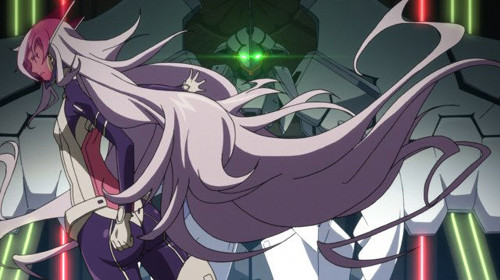
Liberation Girl stars Shoko, the teenage president of Japan in the game's particular future. When her nation is invaded, Shoko does what any duly elected representative would do and boards a flying combat mecha to repel the occupying forces (and possibly avenge the death of her father, Japan's previous chief executive). It bring to mind From Software's Metal Wolf Chaos, which had an American president doing much the same thing.

Shoko's towering Kamui assault robot can switch between aerial and ground-battle versions, and it carries an impressive array of weapons: shield shots that can protect as well as attack, lock-on laser missiles, a close-range energy katana, and an extra-powerful strike synced through the 3DS touch screen. The Kamui and other robots are the work of Shigeto Koyama, while Mahiro Maeda designed the warships and Yusuke Kozaki the characters.
On to Crimson Shroud. Yasumi Matsuno is revered in many circles for stylish RPGs like Final Fantasy Tactics, and Crimson Shroud is his first directing gig since he left Square Enix and joined Level-5. It's an RPG, but made in the old tabletop fashion, where presumably virtual dice rolls decide a player's success in combat and exploration.
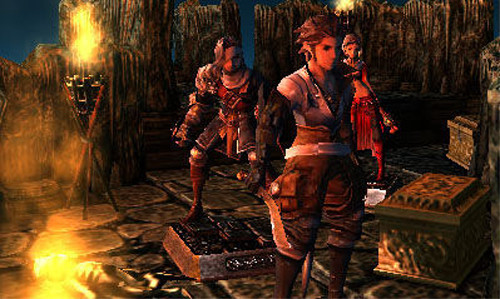
Despite its use of more traditional RPG mechanics, Crimson Shroud looks very much the part of a classic Matsuno RPG. The characters and scenery have a detailed, grimly medieval look, and they wouldn't be out of place in Matsuno's Vagrant Story or Final Fantasy XII. It's also going to sound like a Matsuno piece, as the soundtrack comes from his frequent collaborator Hitoshi Sakimoto. There's also a story behind the dicing and battling, and the lead character is a professional treasure-hunter named Giaque. The rest of the plot lies unrevealed, but some of the introductory footage shows off Matsuno's love of backstories and ethnic feuding.
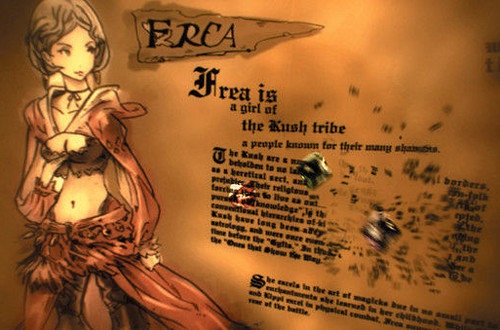
To be fair, we haven't seen as much of the other two Guild 01 games. Seaman creator Yoot Saito has an airport-managing sim in the works, and comedian Yoshiyuki Hirai's title lets players run a weapon shop for RPG adventurers. The collection's out later this year in Japan, and no one's announced an English version. Perhaps American publishers wouldn't bother with an airport-running game, but Liberation Girl and Crimson Shroud look amazing. They're a Yasumi Matsuno RPG and a game about a mecha-piloting teenage girl president. If the whole world doesn't get the chance to play those, there's something very wrong here.
NEW DODONPACHI DRESSES FOR BEACH, STREET, ALIEN BEE INVASION
Donpachi was Cave's first game, and its expanded Dodonpachi franchise is now Cave's largest and most reliable line of shooters. They're all vertically scrolling titles in the vein of Raiden, albeit with powerful lasers and armies of shiny tanks and jets to spit massive volleys of multicolored bullets at the unwary player. Cave has two DoDonpachi offerings this year, and the first, Dodonpachi: Blissful Death, is out right now for the iPhone and iPad.
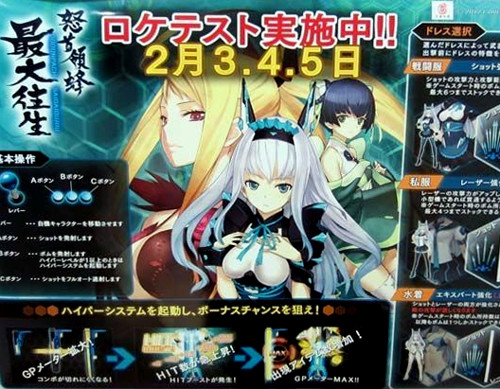
The other Dodonpachi is Saidaioujou, and it was recently on location test in Japanese arcades. The scoring system's still under dissection, but details emerged about the game's...shall we say...unique modes. Dodonpachi Saidaioujou features at least three women pilots designed by Ar Tonelico artist Nagi Ryou, and they change their outfits depending on the player's chosen weapon system. Pick a setting that emphasizes the basic wide-range shot, and they'll wear combat outfits (which are apparently maid-like getups). Pick a powerful laser and fewer bombs, and they'll wear their casual clothes. Pick the toughest difficulty level, with lethal standard fire and only one bomb, and they'll wear bikinis. By this logic, the game should have a novice-player mode where all of the characters wear full medieval armor or clanking Victorian diving suits, but I doubt Cave will consider that.
IN BRIEF: POSSIBLY NOT LAST STREET FIGHTER X TEKKEN CHARACTERS ANNOUNCED, SQUARE HAS MYSTERY GAMES, DOUBLE FINE HAS MONEY
With Street Fighter X Tekken coming the first week of March, Capcom's running out of time to announce new characters. In fact, the latest round is supposedly the last, adding M. Bison, Akuma, Jin, and Ogre to the mix. However, the ESRB watchdogs at Siliconera noticed that the game's rating mentions chainsaws and a “drunk” fighter. Android girl Alisa Bosconovitch wields chainsaws and easygoing cop Lei Wulong uses a drunken style of martial arts, and neither character was announced yet. Alisa and Lei are also Tekken entries, mind you. If they're in the game, the Street Fighter side likely has two more unannounced fighters of its own.
In other news dug up by Siliconera, Square Enix filed several interesting European trademarks: Drakerider, Blood of Chaos, and 774 Deaths. The first two sound mildly like Drakengard and Blood of Bahamut, respectively, but it's 774 Deaths that's most noteworthy. It might just be an English version of Square's Nanashi no Game, an inventive DS horror title where players explore a “real” world and a haunted old-school RPG, with the two blurring together in alarming ways. Still, it's best to be cautious. These are just names for the time being, and many trademarked game titles have come to nothing.
Lastly, I would be no sort of Double Fine nerd if I didn't mention their latest project. Fans often asked Double Fine founder Tim Schafer to make another adventure game in the vein of his LucasArts creations: Full Throttle, Day of the Tentacle, and Grim Fandango. When no publishers bit, Double Fine went to Kickstarter in an attempt to raise $400,000 to fund such a game on their own. They broke a million dollars within one day. And there's still time to donate and get on board for this new adventure game.
FEATURE: THE VITA LAUNCH
The future looks a lot like the present, if the two newest handheld systems are any indication. Just as the 3DS closely resembles the regular DS Lite, the PS Vita doesn't fall too far from the PSP. Of course, it's a much more powerful machine inside, and it amends some of the biggest complaints about its predecessor. The Vita has two analog triggers for starters, and its small game cartridges are less worrisome than the UMD format that Sony enforced on the PSP. Beyond that, the Vita sports a touch-screen, a rear touchpad, and a Sixaxis motion sensor. And it has a darned pretty display for a handheld.
There are trade-offs, naturally. The battery life is reportedly not all that long, lasting about 5 hours at most. The camera's also a puny 1.3 megapixels—roughly what you'd find on a basic flip-open cell phone. And Sony's introduced a new memory card standard, so Vita owners will have to buy a Sony-brand card to save their games, and that's on top of the system's $249.99 price tag. At least there's an healthy game lineup in store for the Vita when it arrives next week. Like the 3DS launch, it's full of ports and familiar franchises, and some stand out more than others.
ARMY CORPS OF HELL Developer: Entersphere Co.
Developer: Entersphere Co. Publisher: Square Enix Platform: PS Vita Players: 1-4 MSRP: $39.99 Army Corps of Hell seems uncharacteristically grim for a company like Square Enix, whose darker moments are usually more like the scream-rock Chocobo theme from Final Fantasy XIII-2. The connections grow stranger upon learning that Entersphere Co. was formed by staff from Nintendo's Pikmin titles, and that Army Corps of Hell is a lot like Pikmin with hellish monsters in place of adorable little space imps. The star of this infernal campaign is a deposed ruler crawling back up from the depths of hell with an army in tow. In his conquest, he commands a legion of disposable goblin hordes who attack and fetch and carry things much like Pikmin. Pikmin from hell, that is. Battles don't reward the complacent, however, so players have to keep their overlord avatar busy directing goblins about the game's various fields of carnage. The little beasts have a variety of formations for attacking and defending in their master's best interests, and they'll even rend fallen enemies into materials for the game's item-crafting system. The game's soundtrack of pounding metal also plays a role, as goblin soldiers are healed through a rhythmic mini-game, and players can discover new musical instruments as Army Corps of Hell trudges onward. Early reviews of the game criticize it as repetitive, but it's still one of the few original titles in the Vita's first wave—unless, of course, you count it as a distant Pikmin sequel. |
DYNASTY WARRIORS NEXT  Developer: Omega Force
Developer: Omega Force Publisher: Tecmo Koei Platform: PS Vita Players: 1-3 MSRP: $39.99 Yes, another game system has arrived, and here stands its legally mandated Dynasty Warriors title. As common as these games may be, it's tough to deny their main selling points: taking control of various historical figures, blazing around the battlefields of ancient China, and whacking aside dozens of enemies with each blow. Dynasty Warriors Next is technically built from Dynasty Warriors 7: Extreme Legends, and it includes a lot of the franchise's staples. Using one of 65 different characters, players can re-enact massive military clashes in a quick, simple, and stress-relieving fashion. The game uses the Vita's regular face buttons for basic gameplay, and the touch screen comes into play for special attacks. Dynasty Warriors Next delivers its battleground chaos in several different ways. Campaign Mode sets up various story scenes from Romance of the Three Kingdoms, with a free choice of main character. Conquest Mode, on the other hand, has players choose a specific faction and take over other territories in a manner similar to Dynasty Warriors: Empires. More importantly, Conquest allows multiple players to share a game session using the Vita's GPS features. Of course, there's also a multiplayer ad-hoc mode for more basic violence.
|
LUMINES ELECTRONIC SYMPHONY Developer: Q Entertainment
Developer: Q Entertainment Publisher: Ubisoft Platform: PS Vita Players: 1-2 MSRP: $39.99 The original Lumines was the best thing about the PSP's launch. A mere puzzle game it was, but the mixture of falling blocks, perfectly integrated sound effects, and background music made for a beautifully hypnotic experience. It was to the PSP what Tetris was to the Game Boy way back in 1989. And Lumines isn't so far away from that humble approach: two-color blocks descend from above, and players must fit them into increasingly large squares and rectangles in order for a rhythmic line to wipe them off the screen. As in Rez, everything gives off a certain musical tone: the blocks landing, the fusion of colors into larger shapes, and the chain reaction of a well-planned sweep. Electronic Symphony adds a few new ideas, including a “shuffle” block that changes the colors around it. Player avatars also influence the game, as each of the 41 icons has a special skill activated by the Vita's touch screen. Then there's a soundtrack with 34 pieces of electronica and its relatives, with Air, Underworld, Aphex Twin, System F, and many other outfits. Personally, the chance to play Lumines in time with the Go! Team's “Apollo Throwdown” is enough of a draw on its own. This Lumines isn't coming out of nowhere like the first on did in 2005, but it might give the Vita the same sort of boost. |
NINJA GAIDEN SIGMA PLUS Developer: Team Ninja
Developer: Team Ninja Publisher: Tecmo Koei Platform: PS Vita Players: 1 MSRP: $39.99 Ninja Gaiden Sigma Plus is ideal for the Vita owners who want to know exactly what they're getting. They're getting the latest version of the Ninja Gaiden we saw on the Xbox back in 2004, when it was a fantastic action title. It wasn't really tied to the old NES Ninja Gaiden games, but it paid them homage with crafty level design and some brutal spikes in difficulty. That helped it set a standard among the action games of its generation, even if few were spurred on by the storyline. It had more in common with Tecmo's Dead or Alive, as shown in hero Ryu Hayabusa's design and a cameo appearance by Ayane. But no one cared when the game let us run on walls and dice through enemies by the truckload. And some fans were content to do all of that again when Tecmo reissued the game as Ninja Gaiden Black and ported it to the PlayStation 3 as Ninja Gaiden Sigma. The Vita edition of Sigma has the same bonuses that the PS3 port added to the original Ninja Gaiden, including extra enemies, mid-air archery, and the chance to play as scantily clad demon-hunter Rachel. Those who went through the console version of Sigma won't see that much new, however. The Vita's motion-sensor controls the game's first-person mode, and there's a new “Hero” setting that makes everything a little easier. At least there's a good selection of “ninja trials” as side attractions, plus the promise of a decent action game to test out the Vita. |
SHINOBIDO 2: REVENGE OF ZEN Developer: Acquire
Developer: Acquire Publisher: Namco Bandai Platform: PS Vita Players: 1 MSRP: $39.99 Shinobido isn't just a line of stealth games; it's a reaction. When the Tenchu series was yanked away from Acquire, the developer responded by cooking up Way of the Samurai and Shinobido. The former series came to North America many times, but the PlayStation 2's Shinobido and its PSP sequel visited only Japan and Europe. The Vita launch is the first time we're getting a Shinobido, though Tenchu fans will note many commonalities. Set a few months after the PSP title, Revenge of Zen follow its main ninja as he's betrayed and left at death's door by the Asuka clan. Zen's path (his Highlander-ish Search for Vengeance, if you will) isn't set in stone, and players can influence the game's ending by taking certain missions from certain clans. As a stealth-action game, Shinobido 2 demands a good bit of sneaking around, though it varies the point of missions from assassinations to thievery. It also doesn't cut corners when it comes to slain foes: Zen has to hide any corpses that he makes, so it's often better to just slip past guards and soldiers. It's also to a player's advantage to grab all sorts of spoils from missions, as Shinobido offers a rather extensive item-crafting mode. The Vita's rear touch pad comes into play during the game's first-person viewpoint, which lets Zen throw kunai, a grappling hook, and other weapons. Is it worth buying a Vita just for the first Shinobido game on these shores? Perhaps not, but early adopters shouldn't ignore it. |
UNCHARTED: GOLDEN ABYSS Developer: SCE Bend Studio
Developer: SCE Bend Studio Publisher: Sony Computer Entertainment Platform: PS Vita Players: 1 MSRP: $49.99 Well, this cements it: Nathan Drake is Sony's mascot now. Not Crash Bandicoot, not Parappa, and certainly not anyone from Battle Arena Toshinden. They're all relics of a bygone era, as today's audiences like an adventurous everyman who's always quick with a joke when he's gunning down hundreds of people. Granted, those people are usually murderous thugs and rival treasure hunters, and Drake will meet many more of them in Golden Abyss. It's actually set before the first Uncharted game, so the story's free to throw in all sorts of things that don't affect the franchise's main arc; things like a romance with the granddaughter of a missing archeologist, the stage of a lost city, and the legend of some Spanish explorers who disappeared while looking for that city centuries ago. Golden Abyss is arguably the biggest Vita launch title, as it packs one of Sony's major franchises into a handheld with a lot to prove. This of course means that everything's scaled down a bit in terms of design, and there's no multiplayer option. That said, the game delivers the same sort of gorgeous scenery that made Uncharted stick so firmly in players' minds, and that may be just what the Vita needs right out of the gate. |
For a Vita showcase, Reality Fighters has the right gimmick: it creates combatants and backgrounds using photos from the system's camera. Little Deviants falls into the same category, as its mini-games exhibit the Vita's touch screen and “Augmented Reality” features.
The Wipeout series bolstered the PlayStation's image back in 1995, and did it again with the PSP in 2005. So it's entirely fitting that Wipeout 2048 is here with eight-player matches and tilt controls. It's not a bad choice, considering that the Vita launch's only other futuristic speed fix is Ben 10 Galactic Racing. For more conventional cars, see F1 Racing, Asphalt: Injection, and ModNation Racers: Road Trip. And for racing in a much vaguer and stranger sense, Namco Bandai's prepping Touch My Katamari, a suggestively titled Vita treatment of the classic roll-it-all-up action game. Early impressions haven't favored it, though.
The Vita's suited well to ports from modern-generation consoles, and the launch sees two 2-D fighters already available on the Xbox 360 and PlayStation 3; Aksys Games has BlazBlue: Continuum Shift Extend, while Capcom delivers Ultimate Marvel vs. Capcom 3. A Vita version of Rayman Origins is available, and so are Gameloft's Dungeon Hunter Alliance and Ubisoft's Michael Jackson: The Experience. And one mustn't forget the sports games: FIFA Soccer, Virtual Tennis World Tour, and Hot Shots Golf Invitational.
NEXT WEEK'S RELEASES
ASURA'S WRATH  Developer: CyberConnect2
Developer: CyberConnect2 Publisher: Capcom Platform: PlayStation 3 / Xbox 360 Players: 1 MSRP: $59.99 At E3 and Comic Con last year, Capcom wisely had an Asura's Wrath demo that found its multi-armed, perpetually outraged hero fighting a boss who, upon defeat, grew larger than the planet itself and tried to squash Asura with one finger. Make no mistake, CyberConnect2 set sights squarely on the realm of over-the-top action games, aiming for extravagances bigger, grander, and possibly dumber than anything seen before. Their creation mines Buddhism, Zoroastrianism, and other faiths just as bizarrely as God of War twisted the Greek pantheon, with the titular Asura starting out as a revered imperial general in a world of curiously advanced ancient technology. Yet he's framed for the emperor's murder and turned into a statue for about twelve thousand years. Upon awakening, he sets out to rescue his daughter, Mithra, from the conspirators who murdered the emperor and, well, basically ruled the world for the past dozen millennia. Oh, and he has six arms. That's two more than those Mortal Kombat guys! Much of Asura's Wrath is down and dirty fighting, with Asura pounding, throwing, and rending asunder all sorts of creatures in a future that's part ancient Buddhist art, part Star Wars. As in God of War and countless other action titles, though, players are prompted to jab specific buttons at certain points, whether it's a simple tap in the midst of combat or a flailing fight to push back an oversized boss. Other challenges find Asura firing energy bolts like bullets and dodging return fire. It's all quite over-the-top, and Asura's Wrath has an undeniably unique look in its stone-and-flesh deities who leap between planets with ease. It stands out a bit less in the story department, judging by Asura's mid-fight lines like “I'll rip out your blind eyes!” One also hopes that Asura's Wrath won't be as much of a pushover as CyberConnect2's last project, Solatorobo, but Asura's manic machismo suggests at least a fair challenge. |
THE EXCEED COLLECTION  Developer: FLAT/Tennen-sozai
Developer: FLAT/Tennen-sozai Publisher: Nyu Media Platform: PC (Steam, GamersGate, GameTap, GameFly, Impulse, Capcom Store) Players: 1 MSRP: $9.99 The unconventionally spelled eXceed shooters are a perfectly good example of how a franchise can flourish entirely within Japan's gaming underground, remaining largely unknown to Western players who don't frequent indie shooter circles. Well, eXceed is no longer a thing of obscurity, as ten bucks now gets any PC owner eXceed – Gun Bullet Children, eXceed 2nd – Vampire REX, and eXceed 3rd — Jade Penetrate Black Package. The three games all look similar at a glance, as they all share the same style of enormous-eyed sorceresses with names like “Celestia Lindwurm” unraveling plots about angels and demons as they flit through waves of glowing enemy bullets. Yet the three games differ a bit in their underlying play. Gun Bullet Children outfits its three playable leads with fairly standard shooter attacks and bombs, though the game borrows from Castle of Shikigami by rewarding players who come as close as possible to touching enemy fire. Vampire REX introduces an Ikaruga-like polarity system, where enemies come in “Saintly” and “Evil” varieties. Characters can switch between the two moral codes, absorbing bullet of the same polarity and inflicting greater damage on enemies of the opposite breed. Jade Penetrate Black Package, aside from having the most amazing title of the three, returns to the original game's bullet-grazing concepts and sports the best production values, complete with a heavy soundtrack. And all three titles make The eXceed Collection a good introduction to the world of Japanese 2-D shooters—and also a recommended buy for anyone hoping to see similar games get official English releases.
|
METAL GEAR SOLID: SNAKE EATER 3-D Developer: Konami
Developer: Konami Publisher: Konami Platform: Nintendo 3DS Players: 1-4 MSRP: $39.99 This 3DS edition of Metal Gear Solid 3: Snake Eater goes way back. It was first shown as a tech demo, entitled The Naked Sample, at the 2010 E3, and Konami decided to make a complete port of Metal Gear Solid 3: Snake Eater not long after that. Originally a PlayStation 2 release from 2004, Snake Eater enjoys a fairly good reputation, as it didn't polarize fans like Metal Gear Solid 2 did. No, Snake Eater's a relatively unpretentious tale of special operative Naked Snake infiltrating a USSR jungle hideout, where rogue Soviets are making a mobile nuclear tank. We say “relatively” unpretentious because Snake Eater is still filled with Hideo Kojima's usual twists: a psychic who makes you tread through the ghosts of murdered enemies, a sniper who can be killed by old age, and all sorts of strange, metafictional oddities that tie into other Metal Gear titles. It also forces Snake to adapt to the environment by camouflaging himself or by killing and eating whatever animals cross his path. Snake Eater gets a few new features for its 3DS outing. The system's camera can turn just about any photo into a camo pattern, and the gyroscope comes into play when Snake balances on ledges or crosses bridges. If you bought one of those CirclePad attachments for your 3DS, you'll find that the second analog nub controls the camera in Snake Eater, just as in the original version. And it's in stereoscopic 3-D, but that's pretty much implicit with any 3DS game, isn't it? |
discuss this in the forum (19 posts) |
this article has been modified since it was originally posted; see change history